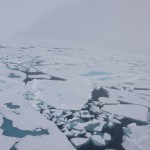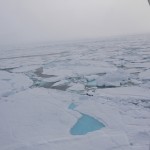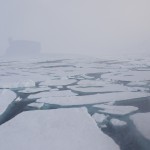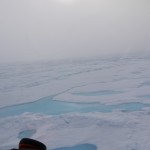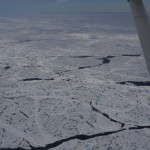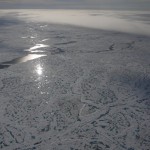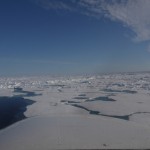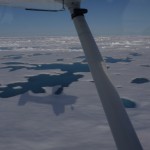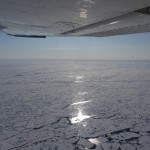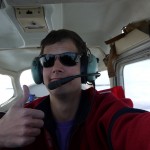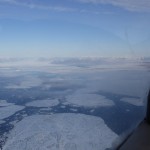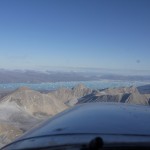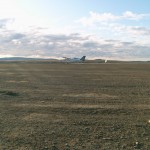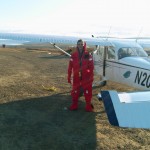There I was, circling around the pole. After 4 turns, calculating my route was a bit too much, and panel mounted GPS failed and started looking for satellite reception. My portable GPS, which was only showing my current position, and was not calculating any route, kept working just fine. I didn’t even have to turn on my 3rd GPS system. I kept circling, and crossed all meridians in the process. A wonderful feeling! After 15 minutes I was satisfied with my circling and flying over the pole, and I started climbing to higher altitudes. I waved goodbye to the Pole, and climbed through the foggy clouds, towards the sun. Putting a new route or waypoint in the GPS didn’t really seem like a good idea, so I based myself upon the gyroscopic compass –which was aligned with the 86°th meridian. After 2 weeks of flying North, I started heading South again. I had the feeling the adventure was over, but reality soon awoke me from that dream. I still had to fly for 6 hours to get back to Eureka.
Just to be on the safe side (and because I made some steep turns over the pole – for the pictures you know), I crosschecked the gyroscopic compass with the position of the sun. I also saw the longitude was more or less constant on the portable GPS, while the latitude was decreasing. Everything was looking good. The panel mounted GPS was still searching for a signal.
I know it must have been impossible, but still, I had the feeling I recognized every cloud, every crack in the ice from my way up North. Then again, everything did look the same, so the chance was pretty big I saw some similar things. White and blue, the only colors you need to paint a landscape. Half an hour away from the Pole, the panel mounted GPS started working again. I entered Eureka as my destination. EET: 5 hours 20 minutes. Flying above clouds in this scenery started to get a little boring. I spent the time writing down every fuel tank switch, when the ferry tank fuel pumps were turned on, every time I changed the gyroscopic compass. But these things only take ten seconds every 20 minutes. Not really an activity to keep you busy very long. My mood increased considerably when after 8 hours of flying, the clouds disappeared again, and I could see the ice. From 7000 ft… It soon struck me that the chances were pretty slim I would ever return here, so I decided to take a closer look at the ice. I saw the North Pole up close, but this time there was no fog and in a sunny sky I started the descend. There was no need to maintain at least 500 ft since there were no people or any other structures around. I leveled off at about 20 feet and trimmed the nose up so that any distraction or turbulence would cause the airplane to move up into the unlimited sky instead of down towards the very close ground. I spend some time following the cracks in the ice, making some very shallow turns, watching the snow and taking some pictures. I could feel the disturbance in the air when I flew over a little heap of snow. I was low. Very low.
After a few minutes, I gained some altitude to safely switch between video camera and movie camera, and I repeated the low level flying once more. It was one of the most beautiful views I had ever seen. My shadow was clearly visible in the snow under the left wing. It danced over the surface, over the water and sometimes disappeared when I made a turn. Twenty minutes later the play time was over. Staying this low could prevent a safe return if I kept burning too much fuel, so I climbed back to 7000ft. This little vertical detour gave me the adrenaline I needed to continue the flight as focused as possible.
It was an hour after this event that the thing I planned for, but dreaded from the beginning of my trip, started to form. A very uncomfortable feeling started to rise. Very uneasy I started to check every instrument, and looked in my bag for the tools to fix it. I tried to focus and hoped the problem would go away. The EET was going down very slowly. Time was creeping by. Every minute felt like an hour, and I started to dawn upon me that it would be impossible to reach Eureka in this state. Fuck. I had to accept the fact, I couldn’t ignore it anymore. I had to pee.
On the bright side: it gave me another task to pass the time. I took the little “Travel John” I brought along, and started to read the manual. All of this while flying at a safe altitude in perfect trim. The package promised it was spill proof. When you are wearing a water proof suit, and you have to pee, it is very advisable you don’t spill anything, since you will carry it along for the remainder of the trip. So “spill proof” sounded very promising. It was time to start steering with the rudder pedals since I needed both hands to position the “spill proof” cup. This is some type of flying they don’t prepare you for in a flying school. It was the only part of the trip I really wished for an autopilot. With a bit of practice I managed to keep the course deviation within 20° and the altitude difference associated with the course changes stayed within 300ft. Perfect flying, spill proof !
A little while after the peeing incident, the mountains of the mainland started to be visible at the horizon. I was now a victim of the coming home feeling. I still had to fly for about 2.5 hours, yet I felt like I made it. These were the longest hours of the trip. You see the mountains, you know the airport is behind them and you just want to get it over with. When I reached the mountains I saw that most of the fog had lifted, which only increased their beauty. Impatiently I enjoyed the scenery. I was crossing mountains, creeks, rivers, water, glaciers and hills again. The once so full ferry tank had shrunk to the size of an empty garbage bag. All the juicy fuel had been converted in the power that was required to propel this airplane through the arctic air over the rooftop of the world and back again. And then there it was, in the middle of all that beauty, as a lighthouse in the dark night: Eureka International Airport.
I tuned in on the radio and was happy to hear a voice. It was almost ten o’clock and normally the station was unmanned during that time. I was very grateful somebody was listening. Once overhead I joined the downwind leg and made a smooth landing. I taxied back to my reserved parking space, close to the fuel, which I would need the next day. I shut down the engine and checked the timer: I flew exactly 12 hours non-stop in a Cessna 172 without auto-pilot.
I opened the door and managed to crawl out of the airplane. My legs were shaking. I looked a bit in disbelief at the airplane. This little piece of metal took good care of me. From the military building a group of people was approaching the airplane. Also the friendly scientist I met the day before was coming to greet me. First there was a quick photo shoot in full immersion suit, which I got out of as soon as possible. Freedom to move my arms and legs again! I gave a quick summary of my trip to the military people, who were most impressed by the fact that I did this with a rental airplane. They offered me a drink, but all I could think about was some real food. I tied the plane to the ground and walked to the weather station. The wind in my hair, a smile on my face. A big one. It was only now, with most of the pressure dissolved, I could really enjoy the Eureka scenery. The water looked more blue, the mountains a bit more brown and orange. The clouds friendly. The wind powerful yet comforting. I felt alive again.
After I ate some leftover food, I met the helicopter pilot in the computer room. He congratulated me and made me promise to take some pictures together for his facebook account (yes, even at 80°N, a facebook account is one of the primordial concerns of any human being). Once the computer was free, I logged in on AvCanada and informed my track team I was safely back in Eureka.
By now, it was almost mid’night’. Under the bright sun I walked back to the tent. One last look to the infinite sky before I taped the window with a trash bag in an attempt to darken the room. I crawled into bed between all the grey gravel that somehow ended up everywhere. And my mind wondered back to the first day I left in the hot Texas desert. I tried to imagine the distance I had covered, all the flying hours the plane endured. The changes in terrain, in altitudes, in temperatures. Good weather, bad weather. Stable, unstable. I felt very lucky everything proceeded more or less as planned. At that time, I was still unaware I my luck would run out the next day. Still care free, I closed my eyes and dozed off. I didn’t dream. I was living my dream.
- North Pole surface
- North Pole surface
- North Pole surface
- North Pole surface
- Frozen ice
- Layered clouds
- Dissolving fog
- Dissolving fog
- Arctic playground
- Hello shadow
- High altitudes again
- High on adrenaline
- Land ahoi! Only 2 more hours to go...
- Crossing mountains once again
- Landing after the North Pole flight
- Shaking me, wearing immersion suit and PLB around the neck.
